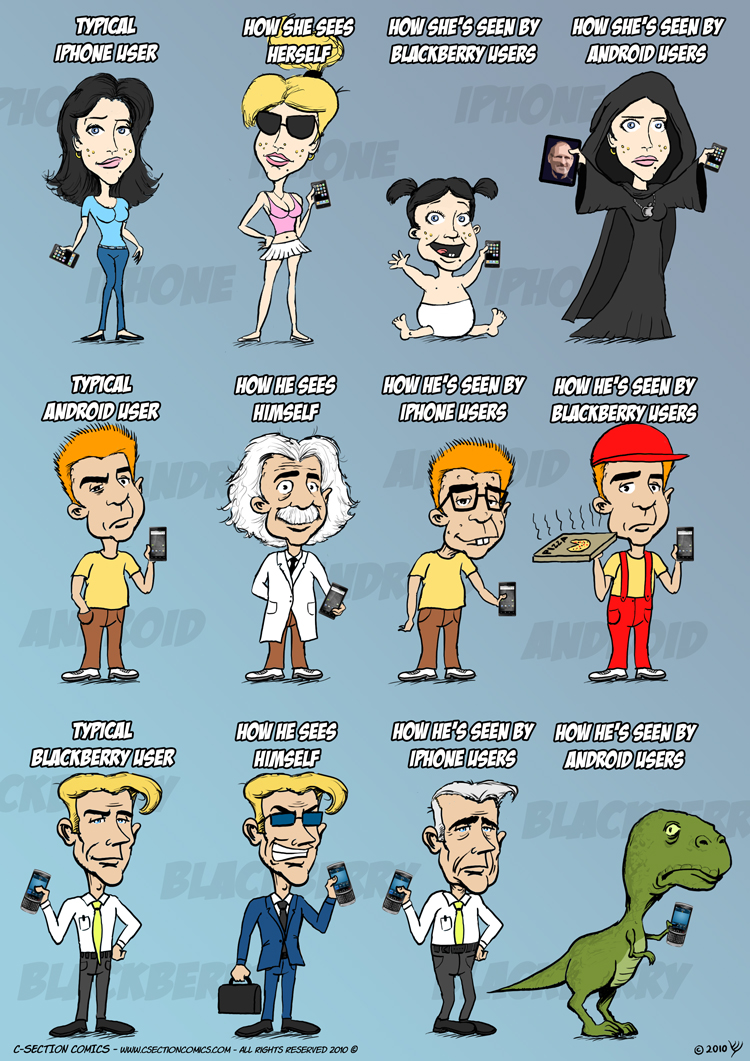Since I’ve recently decided to study iPhone programming and and since Starcraft II is still a few days away, I was able to spend some time learning Objective-C, the programming language of choice for iPhone development. Since, I’ve gone through quite a few programming languages (LOGO, BASIC, Pascal, C, some C++, Java, and more recently Flex), picking up the syntax and the basics was a relative breeze. I expect, as usual, things will get exciting once I start working with the iOS APIs. Haven’t felt this excited in a while!
How Smartphone Users See Each Other
C-Section Comics came up with this matrix of how smartphone users see each other. Pretty accurate if you ask me. Interesting to note that Nokia is not included. It seems it has lost relevance in the smartphone space.
Joining The Side Of The Light
Now that’s a rather ungainly title. The dark side would be Microsoft. The side of the light would be Apple: somehow it evokes images of a supposedly utopian society, open, clean, orderly, and full of happy, contented people. But under the surface is a dark and sinister truth: Steve Job’s and his infamous reality distortion field. Those under its spell goes where he wants them to go and want what he wants them to want.
This is quite ironic since Apple’s famous ad “1984” portrays Apple as the liberator from a controlling entity representing supposedly IBM and, later, Microsoft. The ad is based on the novel of the same name by George Orwell. In the novel, Oceania is totalitarian state whose government controls the speech, actions, and thoughts of its subjects. The ruler of Oceania is the dictatorial Big Brother. These days, Apple is more and more like the Oceania government and Steve Jobs Big Brother.
Still, it’s undeniable that Apple pulled off a mean feat with the iPhone. Apps is is now an everyday word and the millions and millions of users presents a very compelling argument for developing them. Of course, users buy only apps Apple wants them to buy. What is available on the App Store is tightly controlled by Apple. But hey, just develop what Apple wants you to develop!
Unfortunately, you need a Mac to develop for the iPhone. So today, I pulled the trigger on a 13-inch MacBook Pro. I chose it over the slightly less expensive MacBook because of the faster processor, bigger RAM (4GB!), and, of course, the aluminum unibody (call it higher-end-in-an-egalitarian-society look). Plus I still have the capability to develop Android apps. I can even play games (that’s the key thing)!
And so begins my journey to the Apple dystopia and hopefully towards becoming an iPhone developer. But first, Starcraft II!
Wherefore Art Thou Samsung Galaxy S?
Globe supposedly has the exclusive right to sell the Samsung Galaxy S but I’ve been to several Globe business centers and I haven’t seen one. One business center told me it’s not in stock. Another told me it’s on reservation basis with a possibility of delivery in 1-2 months (vs the Apple iPhone 4’s 1-2 weeks). Yet another told me it has been phased out. What is the story really? I wonder if Globe was required by Apple to sell so many iPhone 4s that they’ve decided to curtail sales of its most potent competitor.
The iPhone 4 and the Genius of Apple’s Marketing
You have to hand it over to Apple’s Marketing. They don’t exactly have the best product technically speaking, but they are able to sell and sell lots. Take for example the claims they have for the iPhone 4:
FaceTime – Phone calls like you’ve never seen before.
Reality: False. Video calls, which is what FaceTime is, have been seen before in other phones since 3G came about. Another limitation is that FaceTime requires WiFi. If you have WiFi you could just as well be using video chat apps such as Yahoo! Messenger and Skype (assuming the iPhone lets you run those).
Retina display – The world’s sharpest, highest-resolution phone display.
Reality: True. At 960×640 is the highest out there. But not by much, some phones such as the Samsung Galaxy S (800 x 480) also have relatively high resolutions. Plus resolution is just part of the picture. Super AMOLED is more power-efficient, better contrast ratio, better color reproduction, and faster response time. Check here for more.
Multitasking – Done the right way.
Reality: False. iOS multitasking allows only for specially made apps to run in the background. This is almost like cooperative multitasking which is what Windows 3.1 (remember that?) had. Preemptive multitasking is doing it the right way.
Here’s one ugly reality: The iPhone 4’s antennas are the metals bits on the sides. Your hands can interfere with the signal and in areas of low signal strength, can result in dropped calls.
Here’s another ugly reality: The iPhone 4 has two glass sides compared to previous iPhones. Gorilla glass or not, it has twice the chance of breaking if it falls.
But then I guess Apple’s target market don’t really care much about these things.
